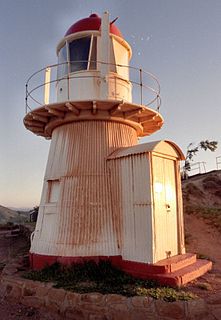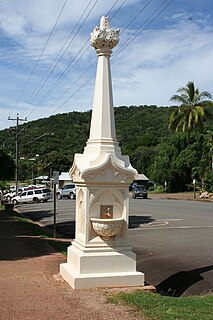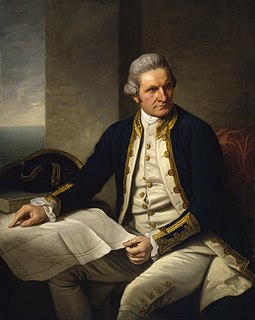
The Annan River is a river located in the Wet Tropics of Far North Queensland, Australia.

Grassy Hill Light, also known as Cooktown Light, is an active lighthouse located on Grassy Hill above Cooktown, Queensland, Australia, on the south side of the entrance to Endeavour River.

Mooney Memorial Fountain is a heritage-listed memorial at 118 Eagle Street, Brisbane City, City of Brisbane, Queensland, Australia. It was designed by William Holloway Chambers and built from 1878 to 1880 by William Webster. It is also known as Eagle Street Fountain. It was added to the Queensland Heritage Register on 21 October 1992.

James Sangster Memorial is a heritage-listed memorial at Browns Park, Downs Street, North Ipswich, City of Ipswich, Queensland, Australia. The memorial was erected to commemorate the heroism of police constable James Sangster who drowned attempting to save two people. It was designed and built in 1898 by C Wilson & Co. It was added to the Queensland Heritage Register on 18 September 2008.

The Esk River is a river located in the Wet Tropics of Far North Queensland, Australia.

Captain Cook's Landing Place is a heritage-listed site at Seventeen Seventy, Gladstone Region, Queensland, Australia. It is so named because Captain Cook landed there on 24 May 1770. It was added to the Queensland Heritage Register on 27 March 1996.

FDA Carstens Memorial is a heritage-listed memorial at Macrossan Street, Port Douglas, Shire of Douglas, Queensland, Australia. It was built from 1907 to 1908 by Melrose & Fenwick (Townsville). It was added to the Queensland Heritage Register on 9 September 2003.

Annan River Bridge is a heritage-listed road bridge over the Annan River at Development Road, Cooktown, Shire of Cook, Queensland, Australia. It was designed by John Henry Daniells and built from 1886 to 1889 by George Herbert Royce & Co. It was added to the Queensland Heritage Register on 21 October 1992.

Mary Watson's Monument is a heritage-listed memorial at Charlotte Street, Cooktown, Shire of Cook, Queensland, Australia. It was designed and built by Ernest Greenway in 1886. It was added to the Queensland Heritage Register on 21 October 1992.

Cook Shire Council Chambers is a heritage-listed former town hall and now museum at 121 Charlotte Street, Cooktown, Shire of Cook, Queensland, Australia. It was built from 1876 to 1877 by Henry J Meldrum and John Sullivan. It was also known as Cooktown Post and Telegraph Office and is now known as Cooktown History Centre. It was added to the Queensland Heritage Register on 8 April 1997.

Cooktown Cemetery is a heritage-listed cemetery at Charlotte Street, Cooktown, Shire of Cook, Queensland, Australia. It was built from 1874 to 1920. It was added to the Queensland Heritage Register on 8 April 1997.

Old Cooktown Hospital is a heritage-listed former public hospital and now Jehovah's Witness Kingdom Hall at May Street, Cooktown, Shire of Cook, Queensland, Australia. It was designed by Francis Drummond Greville Stanley and built from 1879 to c. 1881 by Alfred Doorey & Son. It was added to the Queensland Heritage Register on 21 October 1992.

Cooktown Powder Magazine is a heritage-listed gunpowder magazine at Webber Esplanade, Cooktown, Shire of Cook, Queensland, Australia. It was designed by Francis Drummond Greville Stanley and built from 1875 to 1876 by Henry J Meldrum. It was added to the Queensland Heritage Register on 21 October 1992.

Early Granite Kerbing and Channelling, Cooktown is a heritage-listed set of rainwater management structures at Adelaide, Charlotte, Furneaux, Green, Helen, Hogg, Hope and Walker Streets and Webber Esplanade, Cooktown, Shire of Cook, Queensland, Australia. It was built from 1884 to 1905 by Thomas Pascoe. It is also known as Early Granite Kerbing and Channelling. It was added to the Queensland Heritage Register on 8 April 1997.

Seagren's Building is a heritage-listed workshop at 124 Charlotte Street, Cooktown, Shire of Cook, Queensland, Australia. It was built from 1880s to c. 1900. It is also known as Motor Inn Motel and Seagren's Inn. It was added to the Queensland Heritage Register on 21 October 1992.

Ferrari Estates Building is a heritage-listed former bank building at 126 Charlotte Street, Cooktown, Shire of Cook, Queensland, Australia. It was designed by Eyre & Munro and built from 1890 to 1891 by John Armstrong. It is also known as Bank of North Queensland. It was added to the Queensland Heritage Register on 21 October 1992.

James Cook Historical Museum is a heritage-listed former convent and school and now museum at Furneaux Street, Cooktown, Shire of Cook, Queensland, Australia. It was designed by Francis Drummond Greville Stanley and built from 1888 to 1889 Hobbs & Carter. It was formerly known as St Mary's Convent and School. It was added to the Queensland Heritage Register on 21 October 1992.

Gallop Botanic Reserve, incorporating Cooktown Botanic Gardens, is a heritage-listed botanic garden at Finch Bay Road, Cooktown, Shire of Cook, Queensland, Australia. It was built from 1878 to 1980s. It is also known as Cooktown Botanic Gardens & Recreation Reserve and Queens' Park Gardens & Recreation Reserve. It was added to the Queensland Heritage Register on 13 October 1997.

































